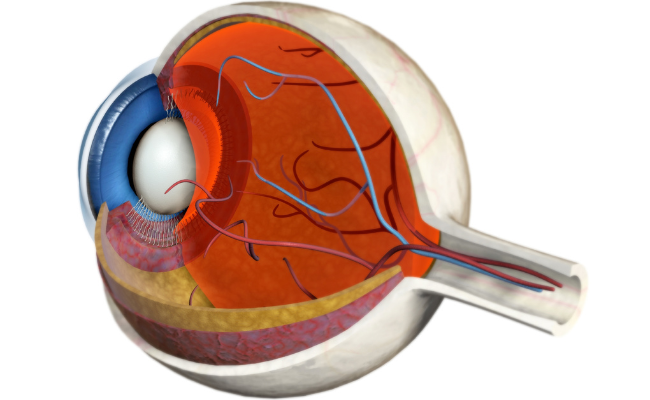How to Treat Retinal Detachment?
- February 14, 2024
- No Comments

What is Retinal Detachment?
Retinal detachment is a critical ocular ailment wherein the retina, a delicate layer of tissue lining the back of the eye, becomes dislodged from its normal position. The retina plays a crucial role in vision by detecting light and transmitting signals to the brain, enabling sight. When retinal detachment occurs, it poses a significant risk of vision loss or blindness if left untreated, necessitating immediate medical attention to avert permanent visual impairment. This condition is typically painless but carries severe consequences for vision. When the retina detaches, it separates from the supportive tissues, leading to a disruption in its blood supply. As a result, the retina loses access to essential nutrients and oxygen carried by the blood vessels in the surrounding tissues, further exacerbating the risk to vision.
Why Does Retinal Detachment Occur?
Retinal detachment can occur due to various factors, including:
- Age-related Changes: As we age, the vitreous gel inside the eye can shrink and become more liquid, leading to increased risk of retinal tears or detachment.
- Eye Trauma: Trauma to the eye, such as a blow or injury, can cause the retina to tear or detach.
- Nearsightedness: Individuals who are highly nearsighted (myopic) have a higher risk of retinal detachment due to the elongation of the eyeball and thinning of the retina.
- Previous Eye Surgery: Previous eye surgeries, such as cataract surgery, can increase the risk of retinal detachment.
- Family History: A family history of retinal detachment or certain genetic factors may predispose individuals to this condition.
- Other Eye Conditions: Certain eye conditions, such as lattice degeneration, retinoschisis, or diabetic retinopathy, can increase the risk of retinal detachment.
How to Treat Retinal Detachment?
Treatment for retinal detachment aims to reattach the retina to its normal position and prevent further vision loss. The specific treatment approach depends on the type, location, and severity of the detachment. Common treatment options include:
- Scleral Buckle Surgery: During scleral buckle surgery, a small silicone band is placed around the eye to gently push the wall of the eye inward, allowing the retina to reattach. This procedure is often combined with cryotherapy or laser photocoagulation to seal retinal tears.
- Vitrectomy: Vitrectomy is a surgical procedure in which the vitreous gel inside the eye is removed to access the retina. The retina is then reattached using special instruments, and a gas bubble or silicone oil may be injected into the eye to hold the retina in place while it heals.
- Pneumatic Retinopexy: Pneumatic retinopexy is a minimally invasive procedure used to treat certain types of retinal detachments. A gas bubble is injected into the vitreous cavity, and the patient's head is positioned to allow the bubble to float to the area of the detached retina, pushing it back into place.
- Laser Photocoagulation: Laser photocoagulation, also known as laser surgery, may be used to seal retinal tears or create scar tissue around the detached area of the retina, preventing further detachment.
- Cryotherapy: Cryotherapy involves freezing the retina using a probe to create scar tissue, which helps seal retinal tears and reattach the retina to the back of the eye.
- Scleral Buckle Surgery: This procedure involves the placement of a silicone band (scleral buckle) around the eye to provide support and relieve traction on the retina, allowing it to reattach.
Treatment Solutions for Retinal Detachment:
- Early Detection and Intervention: Prompt diagnosis and treatment of retinal detachment are crucial for preventing permanent vision loss. Individuals who experience sudden flashes of light, floaters in their vision, or a curtain-like shadow across their visual field should seek immediate medical attention.
- Individualized Treatment Approach: Treatment for retinal detachment should be tailored to the specific characteristics of the detachment, including its location, size, and underlying cause. A comprehensive evaluation by an ophthalmologist or retinal specialist is essential to determine the most appropriate treatment plan for each patient.
- Surgical Expertise: Retinal detachment surgery requires specialized training and expertise. Patients should seek care from experienced ophthalmic surgeons who have a proven track record of success in performing retinal detachment surgeries.
- Postoperative Care: Following retinal detachment surgery, patients require close monitoring and follow-up care to assess the success of the procedure and detect any signs of complications. Compliance with postoperative instructions and scheduled appointments is essential for optimal outcomes.
- Visual Rehabilitation: In some cases, individuals may experience vision changes or impairment following retinal detachment surgery. Visual rehabilitation programs, including low-vision aids, vision therapy, and counseling, can help patients adapt to changes in their vision and maximize their visual function.
Benefits of Treating Retinal Detachment:
- Preservation of Vision: Timely treatment of retinal detachment can prevent further vision loss and preserve remaining vision, allowing individuals to maintain their independence and quality of life.
- Prevention of Complications: Untreated retinal detachment can lead to permanent vision loss and other complications, such as macular degeneration, glaucoma, or retinal scar tissue formation. Prompt intervention reduces the risk of these complications and their associated sequelae.
- Improved Quality of Life: Restoring vision through successful treatment of retinal detachment can significantly improve an individual's quality of life, enabling them to engage in daily activities, work, and recreational pursuits with greater ease and confidence.
- Enhanced Long-Term Outcomes: Early diagnosis and intervention for retinal detachment contribute to better long-term outcomes and visual prognosis. Regular monitoring and follow-up care ensure that any recurrence or complications are promptly addressed, optimizing visual function and overall eye health.
- Patient Education and Empowerment: Educating patients about the signs and symptoms of retinal detachment, the importance of regular eye examinations, and the available treatment options empower them to take an active role in preserving their vision and seeking timely care when needed.
Comments (0)